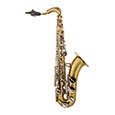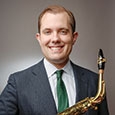The tenor saxophone is a familiar sight in rehearsal rooms and stages, and it is also one of the most recognizable instruments to non-musicians. However, it is often overlooked in teaching and incorrectly equated with the alto rather than treated as the unique, multi-faceted voice that it truly is.

The Tenor Player
In truth, there is no such thing as an alto saxophone player or a baritone saxophone player. All saxophonists are fully capable of playing any member of the family, and students should be encouraged to do just that for the sake of their flexibility and their continued playing once their school days are done. However, there are students who are drawn to specific voices in the family, and the tenor has loyal adherents.
There are few things that might hold a student back as a tenor player. The chief concern is height. Programs that begin in fifth or sixth grade should avoid starting students on tenor because the instrument is too large for most ten- and eleven-year-olds to hold and play comfortably. Instead, start students in these grades on alto. The tenor is best introduced in seventh or eighth grade, when most students will have grown enough that the instrument will be manageable. A student does not need to be of above average height, just tall enough to hold and play the instrument without strange contortions or unnatural posture.
Equipment
Many misunderstandings revolve around tenor equipment. Most manufacturers make at least two models of neckstrap: One for sopranos and altos, and another for tenors and baritones. Be sure a tenor player’s neckstrap is designed for tenor sax. All the weight of the instrument should be supported by the strap; the hands should not support the instrument. Proper sound and technique hinge on this.
There are two common mistakes made with tenor mouthpieces. The first is using a jazz mouthpiece for everything. This causes problems in concert band, in which the role of the tenor is often to blend and provide tonal color, not to stick out. The other mouthpiece problem is the assumption that a popular facing or tip opening for alto will work equally well on tenor. This is rarely the case. Tenor sax mouthpiece models suitable for concert band playing include the Vandoren Optimum TL3, the Vandoren V5 T20, and the Selmer Soloist C**. Many professionals play on one of these options. A strength 3 Vandoren traditional or D’Addario Reserve complete an easy-to-play setup.
Mouthpieces for jazz playing are another matter. Students with a burgeoning interest in jazz might look at metal mouthpieces similar to those used by past famous tenor players. While these are the choice of many professionals, they are quite difficult to play on. Instead, a high-quality hard-rubber jazz mouthpiece is best for many students and schools. Moderate facings by established brands are reliable and can be bought for reasonable prices. An Otto Link hard rubber 6 or a Vandoren V16 T6 will admirably serve the needs of most young jazzers.
To navigate the many saxophone brands available, two rules of thumb apply: If the deal is too good to be true, it is, and if you’ve never heard of the brand, it may not be worth the money. There are many vintage saxophone enthusiasts, but modern saxophones, thanks to improvements in acoustics, intonation, and ergonomics, are the finest ever made. High-quality brands such as Selmer Paris, Yanagisawa, and Yamaha remain the gold standard for all saxophones.
Beware of students pulling down on the tenor’s neck while playing. Although this is correct technique, the architecture of the tenor’s curvaceous neck means that downward pressure can wear on faulty or aging soldering on the neck socket, causing leaks and intonation problems. Directors should keep an eye out for any school- or student-owned horns with necks that are starting to droop. This problem can easily be solved by a repair technician.
Tenor Tone
There is no shortage of excellent tenor role models, including such familiar jazz musicians as John Coltrane, Wayne Shorter, Joe Henderson, Dexter Gordon, and Chris Potter. However, concert tenor playing calls for a different set of role models who may be less familiar to directors and students. One of the most prominent advocates of the tenor as a classical instrument in the last half century has been the American soloist and teacher James Houlik. Much literature for the instrument has been written for him. He teaches at Duquesne University, and many wonderful examples of his playing exist online. Other wonderful tonal role models for students include Stephen Pollock, tenor saxophonist of the New Century Quartet and a student of Houlik’s. In addition, Matthew Levy of the PRISM Quartet has long been one of the finest tenor players in this country and has a velvety, dark, rich sound.
Even many marquee saxophonists associated with the alto and soprano have made excellent, characteristic recordings on the tenor, including Paris Conservatory professor Claude Delangle and Amsterdam Conservatory professor Arno Bornkamp, who for many years has been tenor saxophonist of the Aurelia Quartet. Perhaps the finest of the new breed of classical tenor players is Jonathan Nichol, professor of saxophone at the University of Oklahoma and tenor chair in the H2 quartet.
Students should listen to all of these fine players as much as possible to establish a mental baseline of a great tenor sound. Then, a regime of long-tones, intonation work, and overtone exercises should be commenced.
Articulation
One problem that tends to plague tenor players is faulty articulation. Quite often, the instrument is guilty of slaps and thuds aplenty. This is caused by a misunderstanding of saxophone articulatory technique. The ta articulation is rarely advisable on saxophone, and it can often lead to many problems, especially in the larger horns. Instead, a ti syllable is much more desirable for all saxophones, especially the tenor. It helps with accuracy and lessens the amount of tongue hitting the reed.
Saxophonists should avoid articulating with the airstream. Tenor players who use a huff-and-puff approach will be doomed to failure, as the size of the instrument makes starting and stopping the sound through the breath a nearly impossible task.
Literature
While the tenor literature still lags behind that for alto, there are many exciting new pieces for the instrument being penned, including a sizable body of classic literature for students. No band room or young devotee of the instrument should be without Larry Teal’s Solos for the Tenor Saxophone Player, a large collection of transcriptions with piano accompaniment for players of many levels. Himie Voxman’s Concert and Contest Collection contains many pieces found on solo and ensemble lists throughout the country. Original pieces by Jean-Baptiste Singelee add a unique Romantic challenge for advancing players. Other avenues where the tenor can shine are, of course, the jazz band and the saxophone quartet. In both settings, the instrument is often utilized admirably, with juicy parts for the instrument. This can help assuage the all-too-often underutilization of the tenor in all but the most advanced band literature.
Conclusion
The tenor is a vital, unique voice in the saxophone family that is loved by its adherents but sometimes ignored or treated far too much like the alto. It is its own animal, and a loyal friend to those who respect it.






